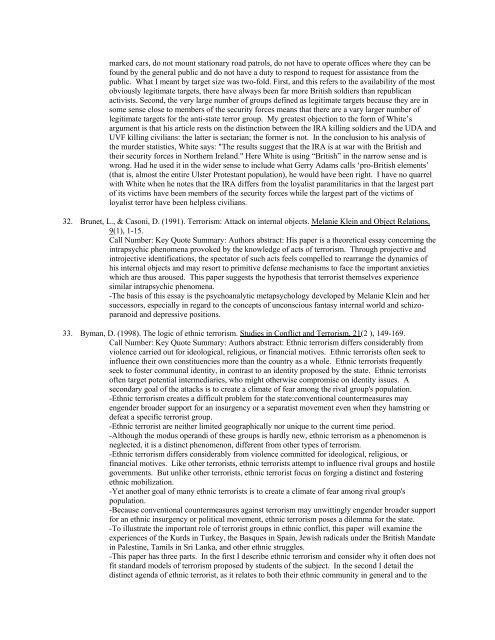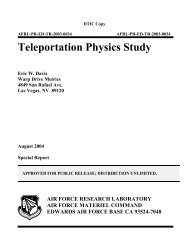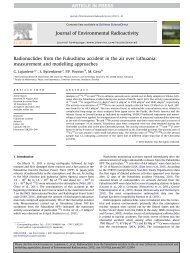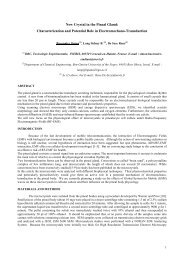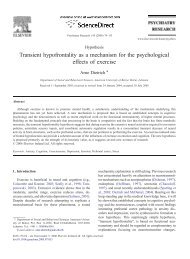Psychology of Terrorism - National Criminal Justice Reference Service
Psychology of Terrorism - National Criminal Justice Reference Service
Psychology of Terrorism - National Criminal Justice Reference Service
You also want an ePaper? Increase the reach of your titles
YUMPU automatically turns print PDFs into web optimized ePapers that Google loves.
marked cars, do not mount stationary road patrols, do not have to operate <strong>of</strong>fices where they can befound by the general public and do not have a duty to respond to request for assistance from thepublic. What I meant by target size was two-fold. First, and this refers to the availability <strong>of</strong> the mostobviously legitimate targets, there have always been far more British soldiers than republicanactivists. Second, the very large number <strong>of</strong> groups defined as legitimate targets because they are insome sense close to members <strong>of</strong> the security forces means that there are a vary larger number <strong>of</strong>legitimate targets for the anti-state terror group. My greatest objection to the form <strong>of</strong> White’sargument is that his article rests on the distinction between the IRA killing soldiers and the UDA andUVF killing civilians: the latter is sectarian; the former is not. In the conclusion to his analysis <strong>of</strong>the murder statistics, White says: "The results suggest that the IRA is at war with the British andtheir security forces in Northern Ireland." Here White is using “British” in the narrow sense and iswrong. Had he used it in the wider sense to include what Gerry Adams calls ‘pro-British elements’(that is, almost the entire Ulster Protestant population), he would have been right. I have no quarrelwith White when he notes that the IRA differs from the loyalist paramilitaries in that the largest part<strong>of</strong> its victims have been members <strong>of</strong> the security forces while the largest part <strong>of</strong> the victims <strong>of</strong>loyalist terror have been helpless civilians.32. Brunet, L., & Casoni, D. (1991). <strong>Terrorism</strong>: Attack on internal objects. Melanie Klein and Object Relations,9(1), 1-15.Call Number: Key Quote Summary: Authors abstract: His paper is a theoretical essay concerning theintrapsychic phenomena provoked by the knowledge <strong>of</strong> acts <strong>of</strong> terrorism. Through projective andintrojective identifications, the spectator <strong>of</strong> such acts feels compelled to rearrange the dynamics <strong>of</strong>his internal objects and may resort to primitive defense mechanisms to face the important anxietieswhich are thus aroused. This paper suggests the hypothesis that terrorist themselves experiencesimilar intrapsychic phenomena.-The basis <strong>of</strong> this essay is the psychoanalytic metapsychology developed by Melanie Klein and hersuccessors, especially in regard to the concepts <strong>of</strong> unconscious fantasy internal world and schizoparanoidand depressive positions.33. Byman, D. (1998). The logic <strong>of</strong> ethnic terrorism. Studies in Conflict and <strong>Terrorism</strong>, 21(2 ), 149-169.Call Number: Key Quote Summary: Authors abstract: Ethnic terrorism differs considerably fromviolence carried out for ideological, religious, or financial motives. Ethnic terrorists <strong>of</strong>ten seek toinfluence their own constituencies more than the country as a whole. Ethnic terrorists frequentlyseek to foster communal identity, in contrast to an identity proposed by the state. Ethnic terrorists<strong>of</strong>ten target potential intermediaries, who might otherwise compromise on identity issues. Asecondary goal <strong>of</strong> the attacks is to create a climate <strong>of</strong> fear among the rival group's population.-Ethnic terrorism creates a difficult problem for the state:conventional countermeasures mayengender broader support for an insurgency or a separatist movement even when they hamstring ordefeat a specific terrorist group.-Ethnic terrorist are neither limited geographically nor unique to the current time period.-Although the modus operandi <strong>of</strong> these groups is hardly new, ethnic terrorism as a phenomenon isneglected, it is a distinct phenomenon, different from other types <strong>of</strong> terrorism.-Ethnic terrorism differs considerably from violence committed for ideological, religious, orfinancial motives. Like other terrorists, ethnic terrorists attempt to influence rival groups and hostilegovernments. But unlike other terrorists, ethnic terrorist focus on forging a distinct and fosteringethnic mobilization.-Yet another goal <strong>of</strong> many ethnic terrorists is to create a climate <strong>of</strong> fear among rival group'spopulation.-Because conventional countermeasures against terrorism may unwittingly engender broader supportfor an ethnic insurgency or political movement, ethnic terrorism poses a dilemma for the state.-To illustrate the important role <strong>of</strong> terrorist groups in ethnic conflict, this paper will examine theexperiences <strong>of</strong> the Kurds in Turkey, the Basques in Spain, Jewish radicals under the British Mandatein Palestine, Tamils in Sri Lanka, and other ethnic struggles.-This paper has three parts. In the first I describe ethnic terrorism and consider why it <strong>of</strong>ten does notfit standard models <strong>of</strong> terrorism proposed by students <strong>of</strong> the subject. In the second I detail thedistinct agenda <strong>of</strong> ethnic terrorist, as it relates to both their ethnic community in general and to the


